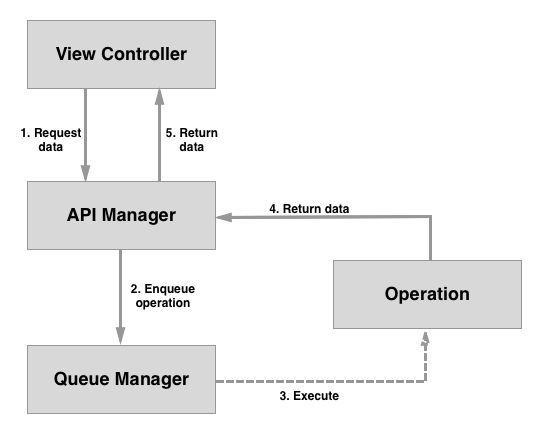Networking with NSOperation as your wingman
This post is based on an
Objective-Cexample. If you are more interested in seeing how to combine networking and operations based on aSwiftexample, head over to the more recent "Building a networking layer with operations" post.
The beautiful and maddening thing about programming is that there are so many ways to solve the same issue. Each solution has its own tradeoffs and as developers, it is up to us to choose the solution that has the most positives for our problem.
Let's take networking as an example.
Before blocks were introduced to iOS you had to use the delegate on NSURLConnection to gradually build up the response from a network request. This resulted in a lot of boilerplate code that more often than not we would abstract away to a base/parent class. This was a good approach and ensured that each class had a well-defined purpose however when blocks arrived things began to change. First, great third-party libraries like AFNetworking began to appear that operated on top of NSURLConnection and then Apple jumped into this block based environment with its new networking layer: NSURLSession (AFNetworking is now built on top of NSURLSession). Both of these approaches offered a more developer-friendly interface by using blocks and removed the need for that base/parent class we spoke about above which made making network requests much easier.
However not everything improved - due to ease of which we could request/respond to networking requests, you started to see a lot more networking code implemented in view controllers 💥. These bloated view controllers made life much harder for developers as we began having view controllers being responsible for multiple different domains - configuring views, responding to user actions, making network requests and parsing network responses. As we know, a well-designed class should have a single responsibility and this erosion of a distant networking layer was making our classes violate the SRP. Now, this wasn't the fault of blocks (which are awesome, btw) but rather a fault with how we choose to use them. By remembering how we used to construct the networking layer with NSURLConnection we can take the best of a distant networking layer and couple it with blocks to produce a project that is more readable and predictable.

Let's start queuing
With NSOperation and NSOperationQueue, we have a great way of isolating the networking code in our projects as it allows us to think of both the network request and parsing of the response as one operation/task that is executed together that is encapsulated with an NSOperation subclass. Now, you may be thinking why not do this with an NSObject subclass and GCD - it could work however I always like to choose the highest level of abstraction (NSOperationQueue is built on top of GCD) and NSOperationQueue offers other fringe benefits such as being able to cancel the queue (when a user logs out), prioritise operations inside the queue (user triggered operations are more important than app triggered operations) and even pause the queue (if the device drops internet connection). If NSOperationQueue is new to you, check out Apple's documentation on it.
With our NSOperation we are going to go down a slightly less well travelled path by creating an operation that won't finish until we say it's finished. Because NSURLSession will push the network request onto a background thread, if we went with the standard NSOperation approach, the queue would spot that once the network request began no work was being carried out on that operation's thread. This lack of work on a typical operation is an indication to the queue that the operation is finished. The queue would then remove the operation from its active operations and all execution of that operation's task(s) would be stopped. So instead of using this typical approach, we are going to have to take control of the operation's state machine to ensure that our operations only end when they have actually completed their task. 3 properties on NSOperation control this:
@property (readonly, getter=isReady) BOOL ready;
@property (readonly, getter=isExecuting) BOOL executing;
@property (readonly, getter=isFinished) BOOL finished;Ready indicates that our NSOperation subclass is good to go and if there is space on the queue, this operation's task can be started.
Executing indicates that our NSOperation subclass is actually doing work at the moment.
Finished indicates that our NSOperation subclass has completed it's task and should be removed from the queue.
As the operation progresses through its lifecycle we will manually change the values for these properties. The other property that we haven't spoken about but that is at the heart of what we are attempting to do here is:
@property (readonly, getter=isAsynchronous) BOOL asynchronousAll of our networking operations are going to be asynchronous so we will override this property to always return YES. Armed with this knowledge let's build a subclass of NSOperation
(I'm going to use NWM (Networking Wingman) as the prefix)
@interface NWMOperation : NSOperation
/**
Finishes the execution of the operation.
@note - This shouldn't be called externally as this is used internally by subclasses. To cancel an operation use cancel instead.
*/
- (void)finish;@implementation NWMOperation
/*
We need to do old school synthesizing as the compiler has trouble creating the internal ivars.
*/
@synthesize ready = _ready;
@synthesize executing = _executing;
@synthesize finished = _finished;
#pragma mark - Init
- (instancetype)init
{
self = [super init];
if (self)
{
self.ready = YES;
}
return self;
}
#pragma mark - State
- (void)setReady:(BOOL)ready
{
if (_ready != ready)
{
[self willChangeValueForKey:NSStringFromSelector(@selector(isReady))];
_ready = ready;
[self didChangeValueForKey:NSStringFromSelector(@selector(isReady))];
}
}
- (BOOL)isReady
{
return _ready;
}
- (void)setExecuting:(BOOL)executing
{
if (_executing != executing)
{
[self willChangeValueForKey:NSStringFromSelector(@selector(isExecuting))];
_executing = executing;
[self didChangeValueForKey:NSStringFromSelector(@selector(isExecuting))];
}
}
- (BOOL)isExecuting
{
return _executing;
}
- (void)setFinished:(BOOL)finished
{
if (_finished != finished)
{
[self willChangeValueForKey:NSStringFromSelector(@selector(isFinished))];
_finished = finished;
[self didChangeValueForKey:NSStringFromSelector(@selector(isFinished))];
}
}
- (BOOL)isFinished
{
return _finished;
}
- (BOOL)isAsynchronous
{
return YES;
}
#pragma mark - Control
- (void)start
{
if (!self.isExecuting)
{
self.ready = NO;
self.executing = YES;
self.finished = NO;
NSLog(@"\"%@\" Operation Started.", self.name);
}
}
- (void)finish
{
if (self.executing)
{
NSLog(@"\"%@\" Operation Finished.", self.name);
self.executing = NO;
self.finished = YES;
}
}
@endThere is a lot of code there but really it is overriding the state machine of NSOperation and allowing us to encapsulate the behaviour needed to create asynchronous operations.
So that's the parent class but let's begin to flesh this out by actually making a network request. StackOverflow has a wonderful open API that we're going to use in the below example.
@interface NWMAnswersOperation ()
/**
Completion block to be called once the request and parsing are completed. Will return the parsed answers or nil.
*/
@property (nonatomic, copy) void (^completion)(NSArray *answers);
@end
@implementation NWMAnswersOperation
#pragma mark - Init
- (instancetype)initWithCompletion:(void (^)(NSArray *answers))completion
{
self = [super init];
if (self)
{
self.completion = completion;
self.name = @"Answers-Retrieval";
}
return self;
}
#pragma mark - Start
- (void)start
{
[super start];
NSURLSession *session = [NSURLSession sharedSession];
NSURL *url = [NSURL URLWithString:@"https://api.stackexchange.com/2.2/answers?site=stackoverflow"];
NSURLSessionDataTask *task = [session dataTaskWithURL:url
completionHandler:^(NSData * _Nullable data, NSURLResponse * _Nullable response, NSError * _Nullable error)
{
NSDictionary *answersJSON = [NSJSONSerialization JSONObjectWithData:data
options:NSJSONReadingMutableContainers
error:nil];
NWMAnswerParser *parser = [[NWMAnswerParser alloc] init];
NSArray *answers = [parser parseAnswers:answersJSON[@"items"]];
if (self.completion)
{
self.completion(answers);
}
[self finish];
}];
[task resume];
}
#pragma mark - Cancel
- (void)cancel
{
[super cancel];
[self finish];
}
@endIn the above example, we are retrieving the data from the answers endpoint, parsing that data, calling the completion block and finishing the operation (so that the next operation can be executed).
You probably spotted that we don't override the main method in the above operation. Instead, we are overriding the start method to contain the body of the task that this operation will complete - this is due to us taking control of the operation's lifecycle.
Getting the managers
NSOperation and NSURLSession work perfectly together to allow you to treat network request and parsing of the response as one task. However, this is only part of the story as we don't want our view controllers to have to access an NSOperationQueue to schedule these network requests.
What we want to do is create a dedicated class that is responsible for creating and scheduling our network requests.
/**
Class to handle all API requests related to answers.
*/
@interface NWMAnswersAPIManager : NSObject
/**
Retrieve answers from API.
@param completion - block that will be called once network request has been completed. Will return an array of answers or nil.
*/
+ (void)retrieveAnswersWithCompletion:(void (^)(NSArray *answers))completion;
@end@implementation NWMAnswersAPIManager
#pragma mark - Retrieval
+ (void)retrieveAnswersWithCompletion:(void (^)(NSArray *answers))completion
{
NWMAnswersRetrievalOperation *operation = [[NWMAnswersRetrievalOperation alloc] initWithCompletion:completion];
[[NWMOperationQueueManager sharedInstance] addOperation:operation];
}
@endThe above manager will schedule the operation to be executed on the relevant queue and allow the view controller to interact with a class method interface (no need for messy instances of the manager to litter your view controller code).
The sharper reader will have spotted another custom class in the above code snippet: NWMOperationQueueManager. This class is responsible for the queue (or queues) that our operation will be added to.
/**
This class coordinates the operations.
*/
@interface NWMOperationQueueManager : NSObject
/**
Returns the global NWMOperationQueueManager instance.
@return NWMOperationQueueManager instance.
*/
+ (instancetype)sharedInstance;
/**
Add an operation to an operation queue.
@param operation - the new operation to be added.
*/
- (void)addOperation:(NSOperation *)operation;@interface NWMOperationQueueManager ()
/**
NSOperationQueue that operations will be added to.
*/
@property (nonatomic, strong) NSOperationQueue *queue;
@end
@implementation NWMOperationQueueManager
#pragma mark - SharedInstance
+ (instancetype)sharedInstance
{
static NWMOperationQueueManager *sharedInstance = nil;
static dispatch_once_t onceToken;
dispatch_once(&onceToken, ^
{
sharedInstance = [[NWMOperationQueueManager alloc] init];
});
return sharedInstance;
}
#pragma mark - Init
- (instancetype)init
{
self = [super init];
if (self)
{
self.queue = [[NSOperationQueue alloc] init];
}
return self;
}
#pragma mark - AddOperation
- (void)addOperation:(NSOperation *)operation
{
[self.queue addOperation:operation];
}
@endThe above manager kind of feels like it's overkill but as you expand your app you will probably find that you want more than one queue (perhaps one for user-driven events and one for system events) then isolating what queue an operation is added to becomes a very useful technique.
Diagrams always liven the party
So what we end up with is the architecture described in the below diagram:

Going home
So there is it one possible implementation of combining NSOperation with NSURLSession to move work off the main queue and simplify the request and parsing of data.
You can find the completed project by heading over to my repo.